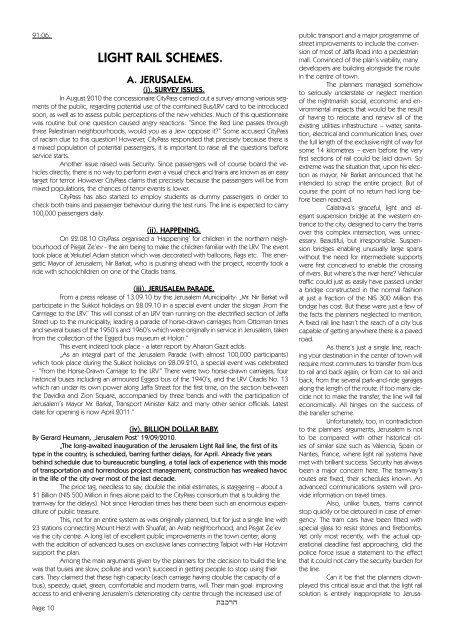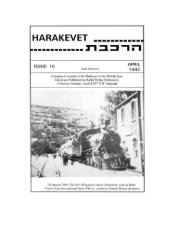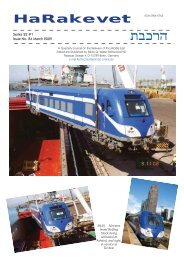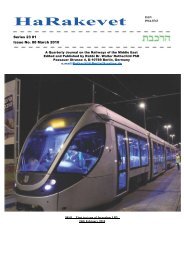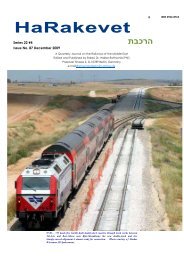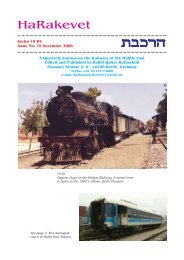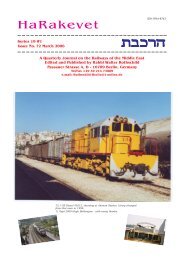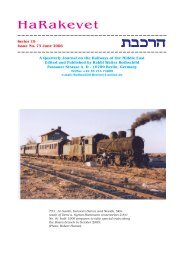You also want an ePaper? Increase the reach of your titles
YUMPU automatically turns print PDFs into web optimized ePapers that Google loves.
<strong>91</strong>:06.<br />
LIGHT RAIL SCHEMES.<br />
A. JERUSALEM.<br />
(i). SURVEY ISSUES.<br />
In August 2010 the concessionaire CityPass carried out a survey among various segments<br />
of the public, regarding potential use of the combined Bus/LRV card to be introduced<br />
soon, as well as to assess public perceptions of the new vehicles. Much of this questionnaire<br />
was routine but one question caused angry reactions: “Since the Red Line passes through<br />
three Palestinian neighbourhoods, would you as a Jew oppose it?” Some accused CityPass<br />
of racism due to this question! However, CityPass responded that precisely because there is<br />
a mixed population of potential passengers, it is important to raise all the questions before<br />
service starts.<br />
Another issue raised was Security. Since passengers will of course board the vehicles<br />
directly, there is no way to perform even a visual check and trains are known as an easy<br />
target for terror. However CityPass claims that precisely because the passengers will be from<br />
mixed populations, the chances of terror events is lower.<br />
CityPass has also started to employ students as dummy passengers in order to<br />
check both trains and passenger behaviour during the test runs. The line is expected to carry<br />
100,000 passengers daily.<br />
(ii). HAPPENING.<br />
On 22.08.10 CityPass organised a ‘Happening’ for children in the northern neighbourhood<br />
of Pisgat Ze’ev - the aim being to make the children familiar with the LRV. The event<br />
took place at Yekutiel Adam station which was decorated with balloons, flags etc. The energetic<br />
Mayor of Jerusalem, Nir Barkat, who is pushing ahead with the project, recently took a<br />
ride with schoolchildren on one of the Citadis trams.<br />
(iii). JERUSALEM PARADE.<br />
From a press release of 13.09.10 by the Jerusalem Municipality: „Mr. Nir Barkat will<br />
participate in the Sukkot holidays on 28.09.10 in a special event under the slogan ‚From the<br />
Carrriage to the LRV.‘ This will consist of an LRV train running on the electrified section of Jaffa<br />
Street up to the municipality, leading a parade of horse-drawn carriages from Ottoman times<br />
and several buses of the 1950‘s and 1960‘s which were originally in service in Jerusalem, taken<br />
from the collection of the Egged bus museum at Holon.“<br />
This event indeed took place - a later report by Aharon Gazit adds:<br />
„As an integral part of the Jerusalem Parade (with almost 100,000 participants)<br />
which took place during the Sukkot holidays on 28.09.210, a special event was celebrated<br />
- “From the Horse-Drawn Carriage to the LRV.” There were two horse-drawn carriages, four<br />
historical buses including an armoured Egged bus of the 1940’s, and the LRV Citadis No. 13<br />
which ran under its own power along Jaffa Street for the first time, on the section between<br />
the Davidka and Zion Square, accompanied by three bands and with the participation of<br />
Jerusalem’s Mayor Mr. Barkat, Transport Minister Katz and many other senior officials. Latest<br />
date for opening is now April 2011.“<br />
(iv). BILLION DOLLAR BABY.<br />
By Gerard Heumann, ‚Jerusalem Post‘ 19/09/2010.<br />
„The long-awaited inauguration of the Jerusalem Light Rail line, the first of its<br />
type in the country, is scheduled, barring further delays, for April. Already five years<br />
behind schedule due to bureaucratic bungling, a total lack of experience with this mode<br />
of transportation and horrendous project management, construction has wreaked havoc<br />
in the life of the city over most of the last decade.<br />
The price tag, needless to say, double the initial estimates, is staggering – about a<br />
$1 Billion (NIS 500 Million in fines alone paid to the CityPass consortium that is building the<br />
tramway for the delays). Not since Herodian times has there been such an enormous expenditure<br />
of public treasure.<br />
This, not for an entire system as was originally planned, but for just a single line with<br />
23 stations connecting Mount Herzl with Shuafat, an Arab neighborhood, and Pisgat Ze’ev<br />
via the city centre. A long list of excellent public improvements in the town center, along<br />
with the addition of advanced buses on exclusive lanes connecting Talpiot with Har Hotzvim<br />
support the plan.<br />
Among the main arguments given by the planners for the decision to build the line<br />
was that buses are slow, pollute and won’t succeed in getting people to stop using their<br />
cars. They claimed that these high capacity (each carriage having double the capacity of a<br />
bus), speedy, quiet, green, comfortable and modern trams, will. Their main goal: improving<br />
access to and enlivening Jerusalem’s deteriorating city centre through the increased use of<br />
,cfrv<br />
Page 10<br />
public transport and a major programme of<br />
street improvements to include the conversion<br />
of most of Jaffa Road into a pedestrian<br />
mall. Convinced of the plan’s viability, many<br />
developers are building alongside the route<br />
in the centre of town.<br />
The planners managed somehow<br />
to seriously understate or neglect mention<br />
of the nightmarish social, economic and environmental<br />
impacts that would be the result<br />
of having to relocate and renew all of the<br />
existing utilities infrastructure – water, sanitation,<br />
electrical and communication lines, over<br />
the full length of the exclusive right of way for<br />
some 14 kilometres – even before the very<br />
first sections of rail could be laid down. So<br />
extreme was the situation that, upon his election<br />
as mayor, Nir Barkat announced that he<br />
intended to scrap the entire project. But of<br />
course the point of no return had long before<br />
been reached.<br />
Calatrava‘s graceful, light and elegant<br />
suspension bridge at the western entrance<br />
to the city, designed to carry the trams<br />
over this complex intersection, was unnecessary.<br />
Beautiful, but irresponsible. Suspension<br />
bridges enabling unusually large spans<br />
without the need for intermediate supports<br />
were first conceived to enable the crossing<br />
of rivers. But where’s the river here? Vehicular<br />
traffic could just as easily have passed under<br />
a bridge constructed in the normal fashion<br />
at just a fraction of the NIS 300 Million this<br />
bridge has cost. But these were just a few of<br />
the facts the planners neglected to mention.<br />
A fixed rail line hasn’t the reach of a city bus<br />
capable of getting anywhere there is a paved<br />
road.<br />
As there’s just a single line, reaching<br />
your destination in the center of town will<br />
require most commuters to transfer from bus<br />
to rail and back again, or from car to rail and<br />
back, from the several park-and-ride garages<br />
along the length of the route. If too many decide<br />
not to make the transfer, the line will fail<br />
economically. All hinges on the success of<br />
the transfer scheme.<br />
Unfortunately, too, in contradiction<br />
to the planners’ arguments, Jerusalem is not<br />
to be compared with other historical cities<br />
of similar size such as Valencia, Spain or<br />
Nantes, France, where light rail systems have<br />
met with brilliant success. Security has always<br />
been a major concern here. The tramway’s<br />
routes are fixed, their schedules known. An<br />
advanced communications system will provide<br />
information on travel times.<br />
Also, unlike buses, trams cannot<br />
stop quickly or be detoured in case of emergency.<br />
The tram cars have been fitted with<br />
special glass to resist stones and firebombs.<br />
Yet only most recently, with the actual operational<br />
deadline fast approaching, did the<br />
police force issue a statement to the effect<br />
that it could not carry the security burden for<br />
the line.<br />
Can it be that the planners downplayed<br />
this critical issue and that the light rail<br />
solution is entirely inappropriate to Jerusa-


